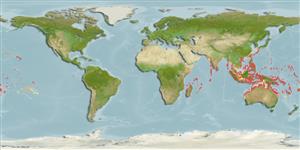Common names from other countries
>
Eupercaria/misc (Various families in series Eupercaria) >
Caesionidae (Fusiliers) > Caesioninae
Etymology: Pterocaesio: Greek, pteron = wing, fin + Latin, caesius = blue grey (Ref. 45335).
More on author: Schultz.
Environment: milieu / climate zone / depth range / distribution range
Ökologie
seewasser riff-verbunden; standorttreu; tiefenbereich 1 - 30 m (Ref. 58018), usually ? - 10 m (Ref. 89972). Tropical; 34°N - 31°S, 39°E - 133°W (Ref. 402)
Indo-Pacific: East Africa, not including the Red Sea or the Arabian (Persian) Gulf, to the Marquesas Islands.
Size / Gewicht / Alter
Maturity: Lm ? range ? - ? cm
Max length : 35.0 cm TL Männchen/unbestimmt; (Ref. 402)
Rückenflossenstacheln (insgesamt) : 10 - 11; Rückenflossenweichstrahlen (insgesamt) : 14 - 16; Afterflossenstacheln: 3; Afterflossenweichstrahlen: 11 - 13. Upper body blue to greenish, lower whitish. 4-6 cheek scales; 24-32 predorsal rays; scaled dorsal and anal fins. Upper peduncular scale rows usually 12 or 13 (12-14); lower peduncular scale rows usually 16 or 17 (15-17). Post maxillary processes 2; posterior end of maxilla tapered. The process on ventrolateral surface of basioccipital for attachment of Baudelot's ligament not extending beyond a horizontal with condyle's rim (Ref. 1723). Caudal fin lobes with dark tips. Head length 3.0-3.7 in SL; body depth 3.4-4.6 in SL (Ref. 90102).
Ranges widely around coral reefs (Ref. 58652) and appears to prefer clear waters of oceanic islands or reefs far from large land masses. Feeds on zooplankton in midwater aggregations. Oviparous, with numerous, small pelagic eggs (Ref. 402). Also caught by drive-in nets. Used as tuna baitfish.
Life cycle and mating behavior
Maturities | Fortpflanzung | Spawnings | Egg(s) | Fecundities | Larven
Carpenter, K.E., 1987. Revision of the Indo-Pacific fish family Caesionidae (Lutjanoidea), with descriptions of five new species. Indo-Pac. Fish. (15):56 p. (Ref. 1723)
IUCN Rote Liste Status (Ref. 130435)
CITES (Ref. 128078)
Not Evaluated
Bedrohung für Menschen
Harmless
Nutzung durch Menschen
Fischereien: weniger kommerziell; Köder: occasionally
Tools
Zusatzinformationen
Download XML
Internet Quellen
Estimates based on models
Preferred temperature (Ref.
115969): 25.2 - 29.3, mean 28.5 (based on 3174 cells).
Phylogenetic diversity index (Ref.
82804): PD
50 = 0.5002 [Uniqueness, from 0.5 = low to 2.0 = high].
Bayesian length-weight: a=0.01072 (0.00467 - 0.02458), b=3.12 (2.94 - 3.30), in cm Total Length, based on LWR estimates for this Genus-body shape (Ref.
93245).
Trophic level (Ref.
69278): 3.4 ±0.45 se; based on food items.
Widerstandsfähigkeit (Ref.
120179): hoch, Verdopplung der Population dauert weniger als 15 Monate. (Preliminary K or Fecundity.).
Fishing Vulnerability (Ref.
59153): Low vulnerability (25 of 100).
